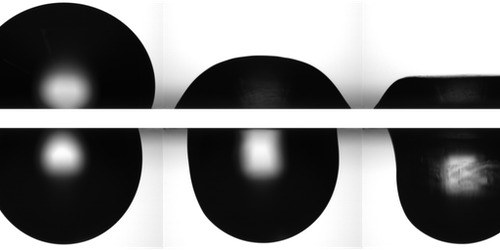Gravity Alters the Shape of an Evaporating Droplet
A droplet’s outline can change as its liquid evaporates, with the exact shape-shift depending on the dynamics of the evaporation process and on the liquid the droplet contains. Droplets of a pure liquid maintain their shape as they get smaller. Those with solutes don’t. Now Davide Riccobelli of the Polytechnic University of Milan and his colleagues have developed a model that can map the changing morphology of an evaporating droplet of a protein solution [1]. The team finds that the shape-shift strongly depends on the direction of gravity’s pull on the droplet and on the interfacial interaction between the droplet and the surface on which it sits. The result suggests new ways to control droplet shape for engineering and biomedical applications.
In their experiments, the researchers attached droplets of a protein solution to the top or bottom of a waxy surface. They then monitored the droplets’ shapes as the liquid evaporated.
For a sitting droplet, the shape initially resembled a half-moon. This half-moon remained until the protein concentration reached a threshold value. At that point a skin formed around the droplet. This skin then crumpled, and the top of the droplet flattened. For the hanging droplet, the initial shape was also a half-moon. But for this system, as the liquid evaporated, the droplet elongated and then developed a wrinkled skin along its sides. This wrinkling happened at the same protein concentration as the crumpling for sitting droplets. Using a model that accounts for gravity, capillary forces, and elastic stresses, the team found that the direction in which gravity pulled on the droplet was the key factor in determining each droplet’s overall shape change and where it creased (the top or the side).
–Rachel Berkowitz
Rachel Berkowitz is a Corresponding Editor for Physics Magazine based in Vancouver, Canada.
References
- D. Riccobelli et al., “Flattened and wrinkled encapsulated droplets: Shape morphing induced by gravity and evaporation,” Phys. Rev. Lett. 130, 218202 (2023).




